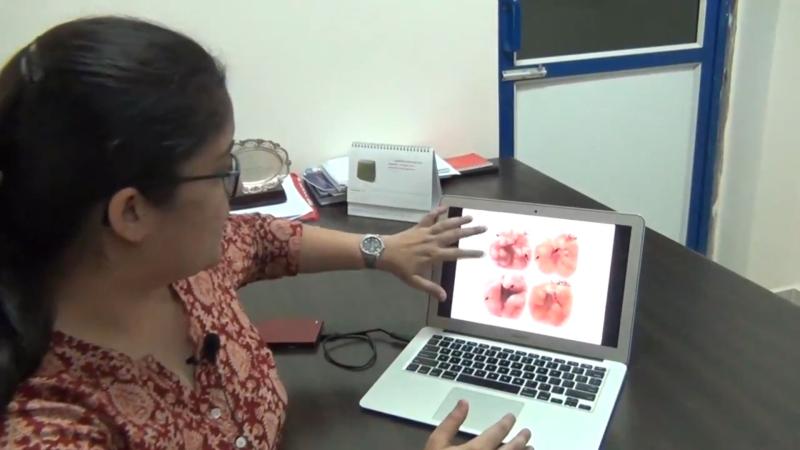
In 2018, around 1.5 million people died from tuberculosis (TB) — an infectious disease that mainly affects the lungs. A major obstacle in the clinical treatment of TB is the long therapy time required to clear the infection. An infected patient needs to take antibiotics for over 6 to 9 months to prevent a relapse — a duration so long that many discontinue their medications. This negligence leads to a recurrence of tuberculosis in such patients and helps Mycobacterium tuberculosis (Mtb), the bacteria responsible for the disease, to become resistant to drugs.
In a recent study, a group of researchers, led by the Department of Microbiology and Cell Biology (MCBL) and Centre for Infectious Disease Research (CIDR) at the Indian Institute of Science (IISc), Bengaluru, have identified factors that aid the tuberculosis bacteria in tolerating drugs for extended durations. Using this new knowledge, they successfully mapped out a drug regimen that uses existing drugs to curb the growth of drug-tolerant Mtb and possibly shorten tuberculosis treatment time.
“This is a significant discovery because we have minimal new drugs to treat tuberculosis. Discovering new anti-tuberculosis drugs is a lengthy process involving tedious approvals, taking 10–20 years to reach clinics from laboratories,” says Prof Amit Singh.
He is an associate professor at MCBL-CIDR and corresponding author of the current study, published in the journal Science Translational Medicine. It was funded by the Wellcome Trust–DBT India Alliance, Department of Biotechnology and DBT-IISc Partnership Program.
When our immune system detects foreign bodies, such as the tuberculosis bacteria, the immune cells such as macrophages ingest these invading particles. They produce oxidants to kill the foreign bacteria, putting them under ‘oxidative stress’. But, when Mtb is ingested, it produces antioxidants that help the bacteria to survive inside the hostile environment of macrophages. In a previous study, the researchers had developed a biosensor to measure the balance of oxidants and antioxidants inside Mtb within the infected macrophages. This allowed the researchers to look inside the TB bacteria and find out how they protect themselves from toxic stress caused by macrophages and antibiotics during infection.
The biosensor helped the researchers to sort out Mtb cells with different states of oxidant-antioxidant balance during infection. They then measured how all the genes of Mtb were expressed in these different states.
“This, coupled with statistical analysis of other publicly available data, allowed us to suggest adaptation mechanisms by which tuberculosis bacteria tolerate multiple antibiotics when they are inside macrophages,” says Dr Aswin Seshasayee, a researcher involved in the study from the National Centre for Biological Sciences, Bengaluru.
Usually, to fight against any infection, macrophages become acidic to create a hostile environment that kills bacteria. However, in the case of drug-tolerant Mtb, the researchers found that they inhabit macrophages that are more acidic than those occupied by drug-sensitive bacteria. These bacteria use acidic pH as a signal to increase their ability to resist oxidative stress during infection. Besides helping them fight the immune cells, this increase provides Mtb cross-protection against anti-TB drugs.
“This gave us a clue that if we can offset the acidic pH in the macrophages, we may be able to reverse drug tolerance,” says Prof Singh.
Interestingly, chloroquine, an anti-malarial drug, and other compounds like bafilomycin and ammonium chloride, are known to reduce acidification in immune cells. The researchers administered bafilomycin, along with an anti-TB drug called isoniazid, to the infected macrophages. They saw a fivefold increase in the death of Mtb with this combination compared with cells that were given only isoniazid. They found a similar increase when chloroquine was used along with another anti-TB drug rifampicin.
The researchers also found that the lungs of TB-infected mice were free of tuberculosis bacteria after eight weeks of treatment with chloroquine and isoniazid. “The lungs looked close to healthy, uninfected lungs,” says Ms Richa Mishra, the lead researcher of this study. In comparison, mice treated with only isoniazid had about 1000 bacteria in their lungs after eight weeks. The scientists observed similar results when chloroquine was used along with rifampicin, although it was not as effective as the combination of chloroquine and isoniazid. Moreover, only three of the five infected mice treated with the chloroquine-isoniazid combination showed relapse after 10 weeks of therapy discontinuation, while all the five mice treated with only isoniazid relapsed.
When the researchers tested the chloroquine-isoniazid combination on infected guinea pigs, whose lungs are infected by TB just like ours, they found similar, encouraging results. Lungs of guinea pigs treated with both drugs had about 10 times fewer colonies of bacteria compared with guinea pigs treated with only isoniazid.
Further, the researchers found that chloroquine had no adverse effects in mice when given along with anti-TB drugs.
“Instead of starting drug design from scratch to identify a molecule that can curb drug tolerance, we can use chloroquine. It is safe and needs very low doses to decrease anti-TB therapy duration and prevent relapse after therapy,” says Ms Mishra.
The results of the study also provide new insights for treating patients infected with both TB and HIV, who usually see low success against TB. When cells infected with HIV were also infected with TB bacteria, the number of drug-tolerant cells increased substantially. The researchers found that chloroquine de-acidifies macrophages with HIV and lowers the development of tolerance against anti-TB drugs.
Moving forward, the researchers plan to test the effect of chloroquine with anti-TB drugs directly on patients and evaluate if it can reduce the therapy duration.
“We plan to fast track these chloroquine-based combinations directly to phase 2 human clinical trials. This will save several years of development time and millions of dollars and revolutionize the way TB can be treated in the coming years,” says Dr. R.K. Shandil, Director and Vice President-Biology at the Foundation for Neglected Disease Research, Bengaluru, who was involved in the study.
This article has been run past the researchers, whose work is covered, to ensure accuracy.






